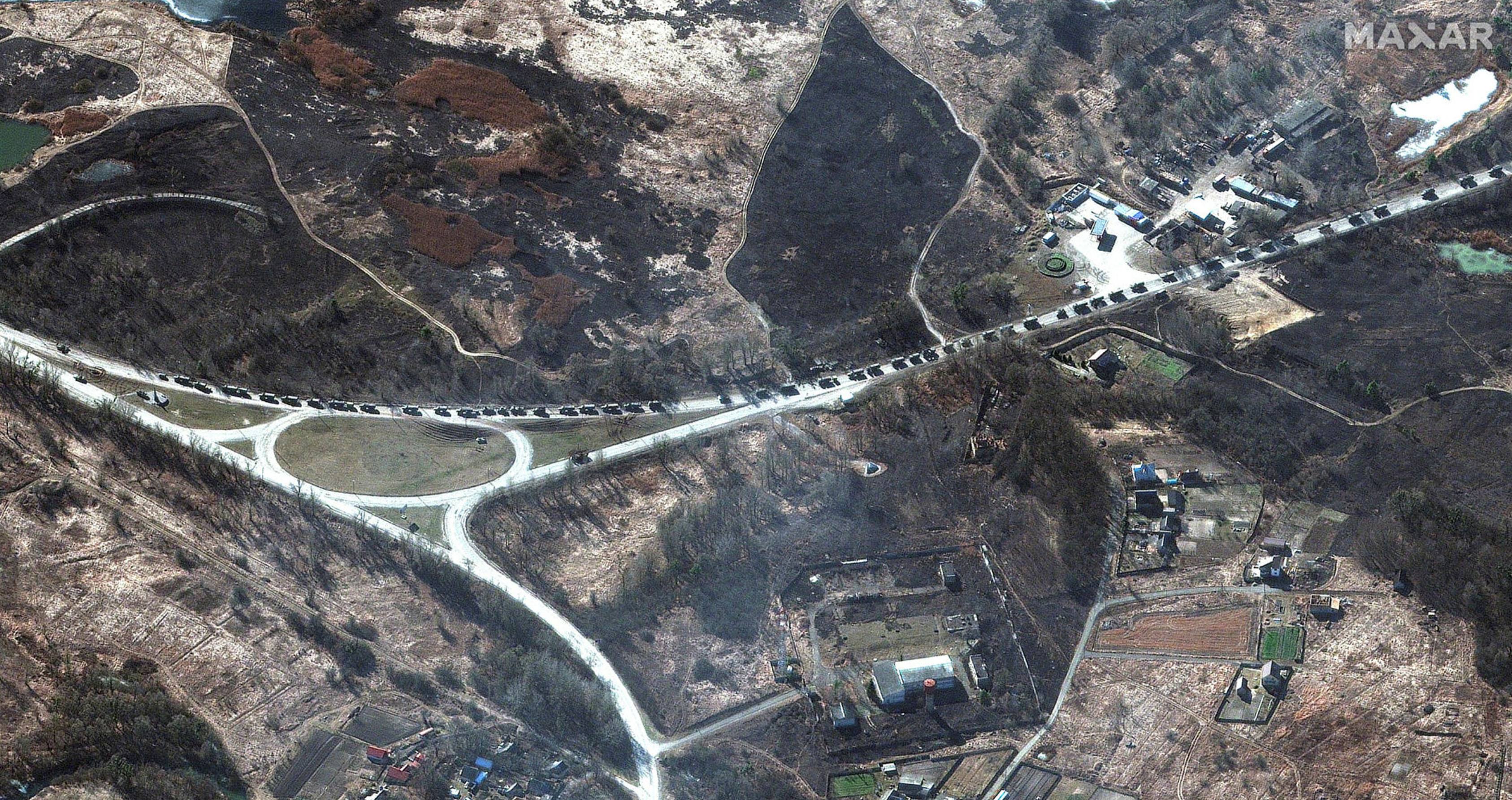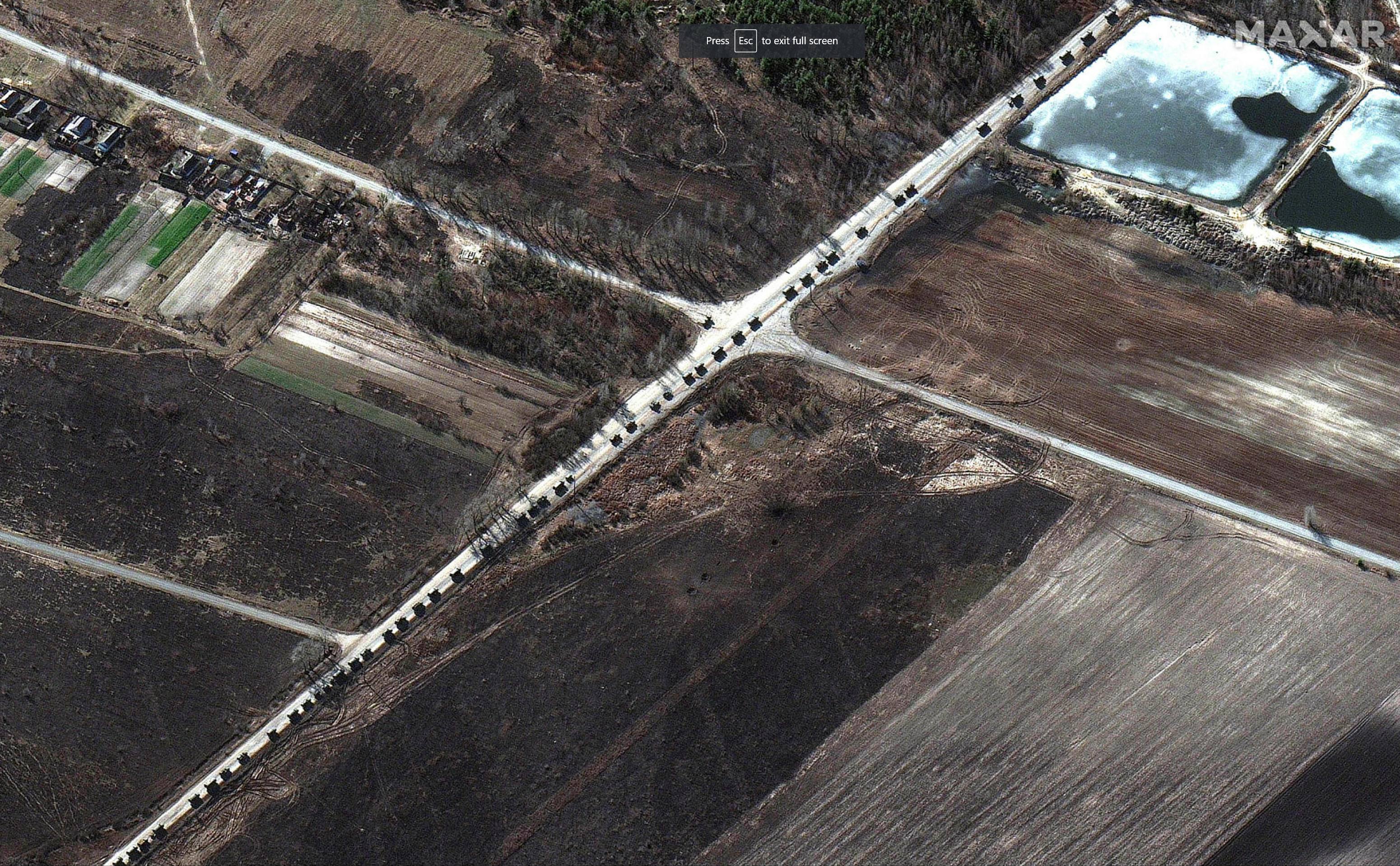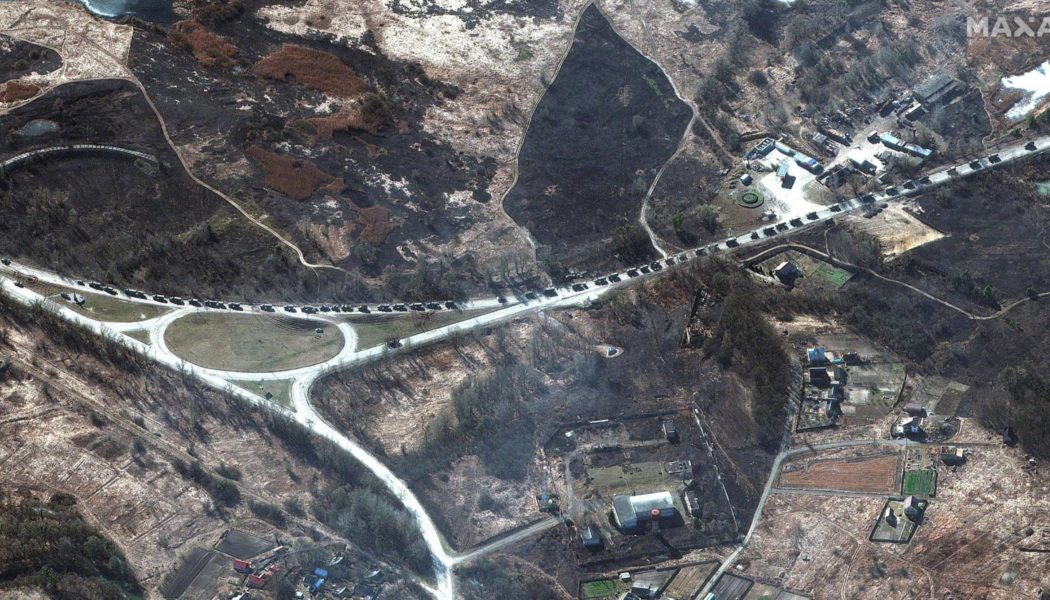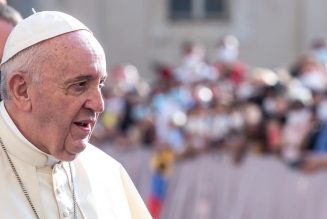The snarled up 65km Russian convoy that was stuck for days outside Kyiv neatly illustrated Moscow’s misplaced belief that it could achieve a lightning-fast victory in Ukraine.
Western military analysts say Russia’s leadership initially thought its “special military operation” would reach the capital and other big Ukrainian cities in days, forcing Volodymyr Zelensky’s government to capitulate and allow a puppet administration to be installed.
“It’s clear that Russia was pursuing regime change in Ukraine,” said Michael Kofman, Russia studies director at CNA, a US think-tank. “Regime change operations are often derived of hubris and bad assumptions — and they usually go terribly wrong.”
Russia’s invasion has not gone to plan, but it has made significant territorial gains, notably in southern Ukraine where its forces have reportedly created a land corridor linking the Crimean peninsula to the Donbas region held pre-war by Russia-backed separatists.
The initial failures have ushered in a new phase of the conflict characterised by heavy bombardments of densely populated areas such as Kharkiv and Mariupol — a tactic Russia used previously in Chechnya and Syria. Ukrainian civilians have borne the brunt of these assaults.
Military experts say Russia’s problems stem from its own disorganisation, underperformance and overconfidence; and the Ukrainian army’s preparedness, supported by weapons and advice from members of the Nato military alliance.
This is an anatomy of the first phase of Russian president Vladimir Putin’s war: how an invasion on three fronts foundered in the face of fierce Ukrainian resistance and Russian shortcomings.
Russia’s approach in the war’s first 48 hours suggested a plan to move rapidly towards key urban centres, where it would force local mayors and officials into submission. But in multiple locations, notably in northern Ukraine, these units quickly outran their supply lines.
In the eastern city of Sumy, for instance, locals filmed Russian troops walking off after parking up their vehicles. “We can assume that’s due to them running out of fuel or ammunition,” said Thomas Bullock, an analyst at Janes, a defence intelligence provider.
The failure to stabilise these supply lines suggests Russia was not planning for any other eventuality, especially not an operation lasting more than three or four days.
“Clearly, the Russian political leadership thought they could make quick gains without destroying urban areas or having to seriously engage with the Ukrainian forces,” said Kofman.
The Russians not only left logistics units behind, they also failed to protect them with infantry or air cover, creating opportunities for the Ukrainians to take them out and cut off the units out front.
“The Ukrainian forces were able to absorb the initial psychological shock of the attack . . . organise themselves, generate reserves, distribute weapons and quickly stymie Russian momentum,” said Kofman.
Ukraine’s tactics have included taking up positions in forests and villages alongside major transport routes used by the Russians, where they can target troops and vehicles via gaps in their convoys.
Ukraine has mainly deployed light infantry units for these ambushes, using shoulder-fired anti-tank weapons. “The main [Russian] guys in the armour sprint ahead up the road, then the logistics try to follow them up, but it’s on roads and in territory they haven’t secured,” said Bullock. “The Ukrainians just have to lie in wait and start taking out the trucks.”
Ukrainian forces have dug trenches around Kyiv in an effort to protect against a full Russian tank attack, including in the suburb of Hostomel, the site of a major airport that was a centre of heavy fighting in the early days of the war.
Ukrainian artillery has also targeted the Russian tank formations on the capital’s outskirts.
“The Ukrainians have done an incredible job of taking a far less numerically and technically superior force, and putting it in positions to highlight their own strengths against the weaknesses of the Russians,” said Philip Breedlove, a former Nato commander now based at the Middle East Institute think-tank.
Ukraine did not have the firepower to take on Russia when its tanks rolled into Crimea in 2014, leading to Moscow’s annexation of the peninsula. This time, however, the international supply of weapons to Ukraine has enabled its military to inflict significant damage.
Multiple countries including the US have supplied weapons to Ukraine, including NLAW and Javelin anti-tank missiles. NLAWs are single-use, portable tubes with a range of up to 800 metres.
Javelins are sophisticated, reloadable missile launchers equipped with night-vision cameras that can reach targets up to 4km away.
TB2 drones bought from Turkey have taken out Russian air defence assets, and US-developed Stinger anti-aircraft missiles have also been deployed in Ukraine.
Key bridges have been destroyed to slow Russia’s advance, including two on the outskirts of Kyiv and one near the Belarus border.
Ukraine’s defence has been aided by a complete overhaul of its military culture since 2014, from a Soviet-style top-down command to one where junior leaders are empowered to take decisions in the field, according to Liam Collins, a former US colonel.
“After eight years of fighting in the Donbas, their junior leaders figured out, ‘We can’t wait for the general to tell us everything, we have to go out and just do it on our own’,” said Collins, who was part of an international task force sent to help Ukraine’s military after the loss of Crimea. “In the speed of war, you have to do that.”
Russia’s military, by contrast, is characterised by top-down decision-making, emanating from Putin himself. The invasion’s first days show what happens when a military tries to enact the will of just one man, according to Kofman.
“People expected Putin would have these assumptions but that the Russian military would push back,” he said. “Instead, it’s clear somebody told him, ‘Yeah, this completely absurd operation that you think we can conduct in Ukraine in the opening days will work’.”
For example, Russia appeared to keep adding units to the huge convoy stuck outside Kyiv despite the fact it had not moved for days, stopped by a likely combination of fuel shortages, vehicle breakdowns, Ukrainian attacks and obstacles ahead.

Satellite footage of the stalled Russian convoy. Source: Maxar
Kofman said he believed it was likely that Putin ordered a certain amount of manpower and material to get to Kyiv in a set timeframe, and that “the only way that could happen is if you literally take all of it and drive it down the shortest road to the capital”.

Satellite footage of the stalled Russian convoy. Source: Maxar
After the Ukrainians counter-attacked and blew up river crossings, it would have been necessary to move bridge-building equipment positioned at the back of the Russian column to the front, said Kofman.
Breedlove added: “This is very much the Russian style: they have a plan . . . and in the absence of orders being changed from above, they’re going to execute no matter what.”
Secrecy around Russia’s intentions leading up to the invasion has been another hindrance to its advance. Interviews released by Ukraine of Russian prisoners of war captured in the first week of the conflict suggest soldiers were not told they were going to invade.
“The Russian forces on the border, some of them had no idea what they were doing. Some thought they were going to do exercises,” said Breedlove. “When they arrived, and they found out what they were actually doing, there was surprise, dismay.”
Kofman added: “Russia’s military was organisationally and psychologically unprepared for this war, and the planning choices made compounded those deficits.”
A lack of communication from leadership was exacerbated when Russian soldiers were confronted by angry Ukrainian citizens. In the north-eastern town of Bakhmach, for example, locals stood in front of Russian tanks.
Overconfidence was another damaging result of Moscow’s top-down system. “Russia was listening to its own propaganda, that Ukraine is really not Ukraine, it’s just Russia,” said Breedlove, adding that the leadership thought its neighbours would receive the Russian army as liberators.
In fact, Ukraine had been preparing for years to fight back in the event of a Russian attack. Everyone, from the president and chief of defence to the troops on the ground, was “worried 100 per cent about a full-scale invasion”, said Collins.
The expectation that Ukrainian resistance would be minimal can be seen in Russia’s early moves. Scott Boston, senior defence analyst at Rand Corporation, said an invading army would only rush into a city if it believed surrender was imminent and the priority was confiscating weapons from potential insurgents. “It turns out that getting there really fast is a good way to get shot in the face,” he said.
The light-armoured Rosgvardia force, traditionally sent in to hold populations, was in some cases sent out in front. “You have Rosgvardia units getting themselves killed because they thought they were going to go into these cities and take over without any support or co-ordination with the actual Russian military,” said Kofman. “Russian units really were operating in the first part of the war as though they were still driving around in their own country.”
“In the opening days of the war, you really didn’t see combined arms operations,” said Kofman, listing “tank companies without infantry support, motor rifle [troops] on the road without tanks, support units on their own without escort.”
Hubris was also evident in Russia’s attempt at the outset of hostilities to seize Hostomel airfield outside Kyiv with about 200 paratroopers supported by helicopters, said Bullock.
“They [would usually] send in a lot more troops supported by artillery and light armoured vehicles,” he said. “For this assault, however, they appeared to think, ‘We can just catch these airfields and won’t meet much resistance so we don’t need to commit’.”
Russia has fared much better in its opening campaign in southern Ukraine. Crucial to this was the early capture of a bridge over the Dnipro river, “a huge milestone for the Russians, and they’ve capitalised on it ever since,” said Bullock. The captured bridge is just outside the city of Kherson, which fell to Russia six days later.
While Russia deployed similar tactics across Ukraine, its southern success was partly down to having a different type of objective there. “If you’re sprinting for a bridge, that’s very different to a city,” said Bullock. “You can secure a bridge very quickly . . . You don’t even really have to engage with the [nearby] town as a whole.”
In the south, Russia deployed formidable forces from Donbas and Crimea. The 58th army, which attacked from the peninsula, is one of the larger, better equipped and better trained forces, said Boston. It could also count on support from Black Sea Fleet ground units and airborne forces, added Bullock. Supply lines in the south are also shorter.
The weather has also played a significant role. While the ground in southern Ukraine is hard, much of the north has been unseasonably muddy, which Breedlove said became “a huge problem” for the Russian forces. “Nearly every time the tanks tried to deploy off of the roads, they got stuck.”
Russia’s gains can also be explained by a failure of Ukraine’s tactics in the southern theatres. “When they were fighting on the outskirts of [the city of] Melitopol, they were trying to do armoured engagements and they did lose a couple of tanks,” said Bullock.
Western sympathy with Ukraine means the open source intelligence environment does not necessarily show its difficulties as often as its successes. “What you see on Twitter is one very distinct narrative . . . That is a very distorted picture of the battlefield,” said Kofman. “We need to be accountable intellectually for what we see and don’t see.”
One puzzle of the war is why Russia has not made greater use of its superior air power. One explanation could be the defending force’s use of anti-air weapons. Russia only executed two waves of air attacks in the first days of the war, said Breedlove, such as on the Dnipro river outside Kherson.
“There are only a few air forces in this world truly capable of the suppression of enemy air defences,” he said. “The western world gave Russia credit for the ability to do this.”
He continued: “It does not appear they have demonstrated that ability in this fight because a relatively smaller and less technically able air defence system has stood much longer than Russia expected.”
Failure to take out Ukraine’s air defences meant Russia has not been able to carry out combined attacks in which aircraft support troops on the ground, added Breedlove. “We don’t see sophisticated support for their ground troops from their air force.”
For Kofman, the surprise comes down to the difficulties in assessing the effectiveness of a military without having seen it in comparable campaigns. “Russia hasn’t tried anything on this scale, against a country the size of Ukraine, and an opponent with some significant parity of capability,” he said.
A new and potentially more bloody chapter of the war is now under way as Russia changes its battlefield tactics.
“We’re definitely in a second phase of the war,” said Justin Bronk, research fellow at the Royal United Services Institute think-tank. “We’re increasingly seeing the Russian military starting to fight like they normally fight.”
This means it will increasingly resort to methods tried and tested in previous conflicts, an approach that can be seen in its assault on Mariupol. The port has been subject to a ferocious Russian bombardment that has flattened much of the city and killed a large number of civilians.
“They seem to be falling back on the extremely brutal, but unfortunately very successful, pattern in Syria and Grozny [in Chechnya] — besiege them, cut them off,” said Bronk. “Shell people until starvation and bombing just compels a surrender.”
Kofman added: “Now they realise they’re in for a serious fight . . . this war is going to get uglier.”
Join Our Telegram Group : Salvation & Prosperity









